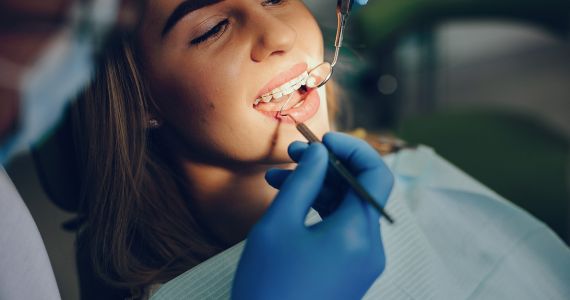

Tooth Crown and Dental Bridge Dentistry in Yuma, AZ
When it comes to restoring the function and appearance of damaged or missing teeth, dental crowns and bridges are some of the most reliable solutions available today. At Yuma Dental Clinic, we understand the importance of maintaining a healthy and beautiful smile. In this comprehensive guide, we will walk you through everything you need to know about dental crowns and bridges, from the types available to the procedures involved.
Whether you are considering these treatments for cosmetic purposes or to improve your oral health, this article will give you all the information you need to make an informed decision.
What Are Dental Crowns and Bridges?
Dental crowns and dental bridges are fixed prosthetic devices used to restore teeth that are damaged, decayed, or missing. While they are similar in their ability to restore the appearance and function of teeth, they are used in different situations.
Dental Crowns
A dental crown is a cap that fits over a damaged or decayed tooth, essentially restoring its shape, size, and strength. Crowns are commonly used to protect teeth that have been weakened by large fillings, root canal treatment, or cracks. They can also improve the appearance of teeth with severe discoloration or damage.
Dental Bridges
A dental bridge is used to replace one or more missing teeth. It works by anchoring artificial teeth to the adjacent natural teeth or dental implants. A bridge is designed to restore both the function and appearance of the missing tooth, helping to prevent shifting and other complications that arise from tooth loss.
Why Are Dental Crowns and Bridges Necessary?
There are several reasons why dental crowns and bridges are important for maintaining oral health. Here are the most common situations in which these treatments are needed:
Protecting Weak Teeth: Crowns are often used to protect teeth that are severely weakened due to decay or injury. Without a crown, these teeth could break or become more damaged.
Restoring Missing Teeth: A dental bridge can replace one or more missing teeth, restoring both function and appearance. This helps maintain the proper alignment of your teeth and prevents other teeth from shifting into the empty spaces.
Enhancing Aesthetics: Crowns and bridges can greatly improve the appearance of discolored, misshapen, or damaged teeth. With these treatments, you can achieve a natural-looking smile that enhances your confidence.
Restoring Tooth Function: If you are missing teeth or have a tooth that is severely damaged, you may have difficulty chewing or speaking properly. Dental crowns and bridges restore the normal function of your teeth, making it easier to eat and talk.
Our Clients

Sarah T
- Dental Care Patient

Mark L
- Dental Care Patient

Emily R
- Dental Care Patient
Types of Dental Crowns and Bridges
At Yuma Dental Clinic, we offer several types of dental crowns and bridges, each designed to meet different needs and preferences. The right choice for you will depend on factors such as the location of the tooth, your budget, and your aesthetic goals.
Types of Dental Crowns
Porcelain Crowns: Porcelain crowns are known for their natural appearance and are ideal for teeth that are visible when you smile. They blend well with the color of your natural teeth and provide excellent aesthetic results.
Metal Crowns: Made from materials like gold or other metals, metal crowns are highly durable and ideal for teeth that are not visible. They are typically used for molars or back teeth that are subjected to heavy chewing forces.
Porcelain-Fused-to-Metal Crowns: These crowns combine the strength of metal with the aesthetic appeal of porcelain. They are commonly used for both front and back teeth, providing a good balance of durability and appearance.
Zirconia Crowns: Zirconia crowns are a newer option that offers both strength and a natural look. They are made from a durable ceramic material and are ideal for patients looking for long-lasting, aesthetic results.
Types of Dental Bridges
Traditional Bridges: The most common type of bridge, traditional bridges involve creating crowns for the teeth on either side of the missing tooth, with a false tooth (pontic) placed in between. This type of bridge is highly effective when the adjacent teeth are healthy and strong.
Cantilever Bridges: Cantilever bridges are used when there is only one adjacent tooth available to anchor the bridge. They are most commonly used in situations where a single tooth is missing, and there is a need for a stable and functional restoration.
Maryland Bridges: Also known as resin-bonded bridges, Maryland bridges are made of porcelain or metal and are used to replace missing teeth in the front of the mouth. They are bonded to the adjacent teeth using a special resin, making them less invasive than traditional bridges.
Implant-Supported Bridges: Implant-supported bridges use dental implants as the anchor points, providing a more permanent solution for missing teeth. This type of bridge is ideal for patients who have lost multiple teeth and want a highly stable restoration.
The Procedure for Getting Dental Crowns and Bridges
The process of getting dental crowns and bridges typically involves multiple visits to your dentist. Here’s a breakdown of what you can expect:
Step 1: Consultation and Examination
The first step in getting a dental crown or bridge is a consultation with your dentist. During this visit, your dentist will examine your teeth and take X-rays to assess the extent of the damage or tooth loss. If a crown or bridge is deemed appropriate for your situation, your dentist will discuss the different options available to you and help you choose the best one.
Step 2: Tooth Preparation
If you are getting a crown, the affected tooth will need to be prepared. This involves removing any decay and reshaping the tooth to ensure the crown fits properly. For a bridge, the adjacent teeth will be reshaped to allow room for the crowns that will anchor the bridge.
Step 3: Impressions and Temporary Restoration
After preparing the teeth, your dentist will take impressions of your teeth. These impressions will be sent to a dental laboratory, where your crown or bridge will be custom-made. While you wait for the permanent restoration, your dentist will place a temporary crown or bridge to protect your teeth.
Step 4: Fitting and Adjustment
Once your permanent crown or bridge is ready, you will return to your dentist for the fitting. The crown or bridge will be placed over the prepared teeth, and your dentist will check the fit, color, and bite. If necessary, adjustments will be made to ensure a comfortable and natural-looking result.
Step 5: Final Placement
After any necessary adjustments, your crown or bridge will be permanently cemented in place. You’ll leave the office with a restored smile that looks and feels natural.
Benefits of Dental Crowns and Bridges
There are many benefits to choosing dental crowns and bridges for restoring your smile. Here are some of the most notable advantages:
Durability: Dental crowns and bridges are highly durable and can last for many years with proper care.
Improved Function: Both crowns and bridges restore the function of your teeth, making it easier to chew and speak properly.
Enhanced Appearance: With materials like porcelain, dental crowns and bridges can be made to look just like natural teeth, providing a beautiful, natural-looking smile.
Prevent Further Damage: By covering a damaged or decayed tooth, a crown can prevent further damage and protect the underlying tooth structure.
Prevent Tooth Shifting: A bridge can prevent neighboring teeth from shifting into the gap left by a missing tooth, helping to maintain proper alignment.
Aftercare for Dental Crowns and Bridges
To ensure the longevity of your dental crowns and bridges, it’s important to take good care of them. Here are some aftercare tips:
Brush and Floss Regularly: Maintain good oral hygiene by brushing at least twice a day and flossing daily to prevent plaque buildup around your crowns and bridges.
Avoid Hard Foods: Be cautious when eating hard foods that could damage your crowns or bridges. If you have metal crowns, avoid biting down on very hard substances like ice.
Visit Your Dentist Regularly: Regular check-ups will allow your dentist to monitor the condition of your crowns and bridges and make any necessary adjustments.